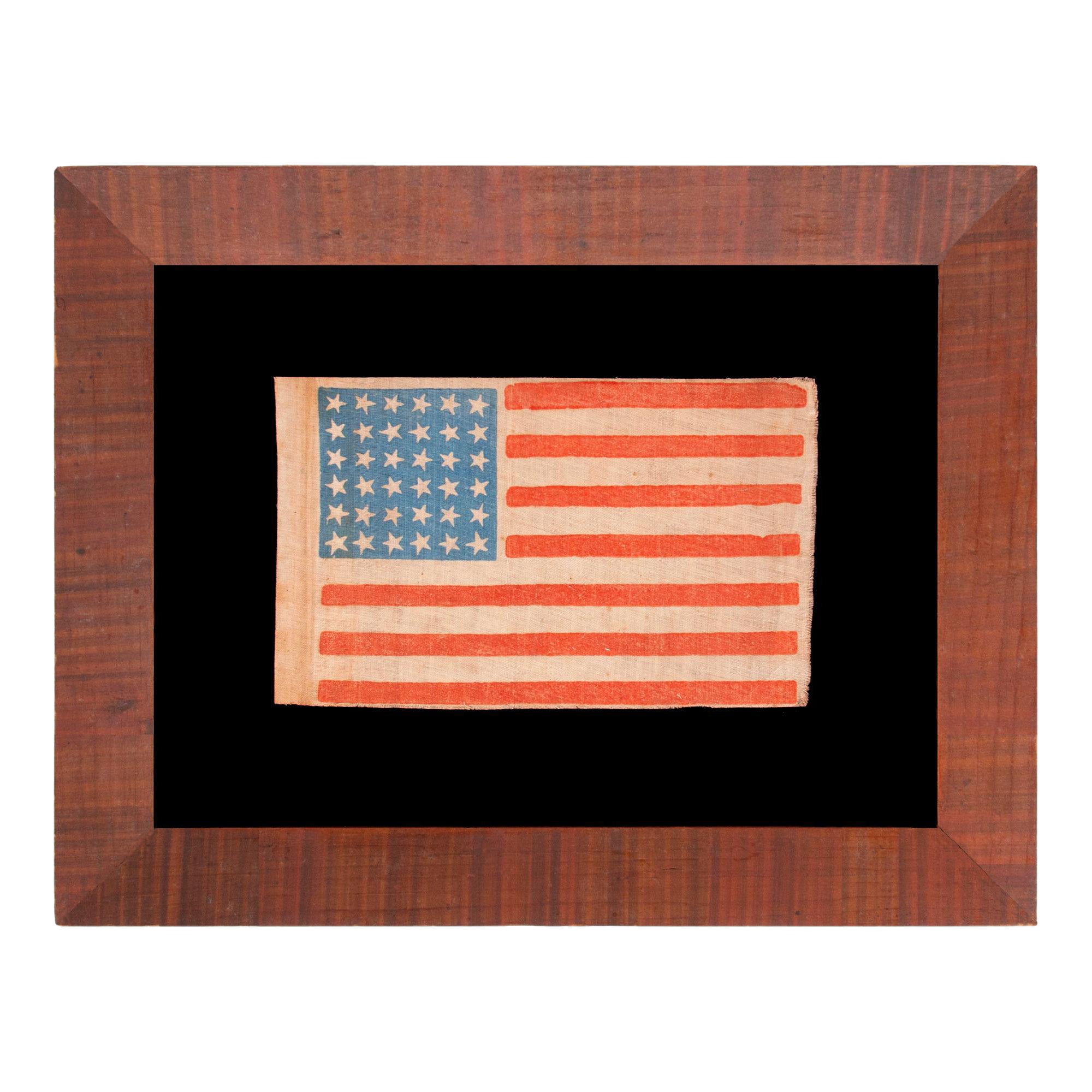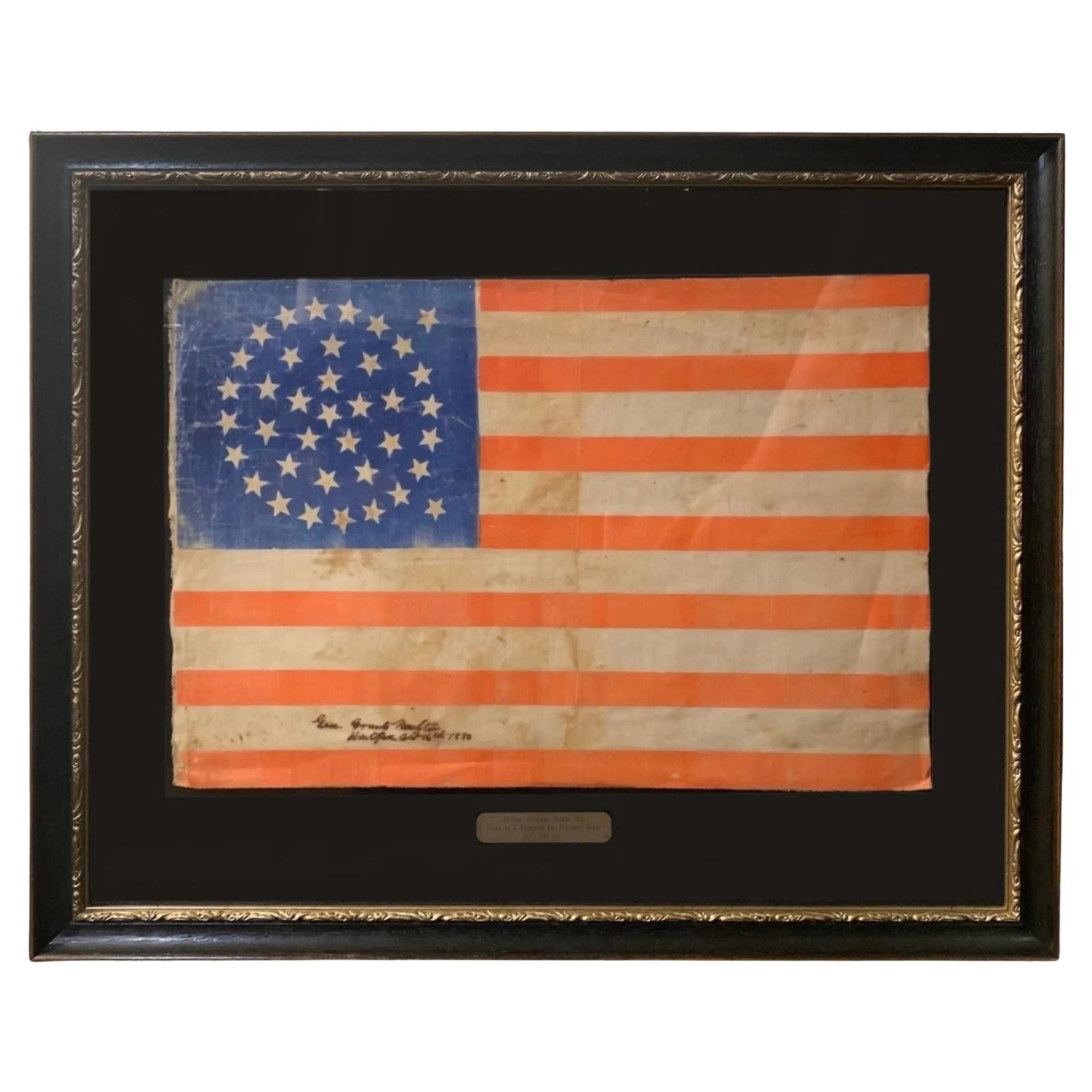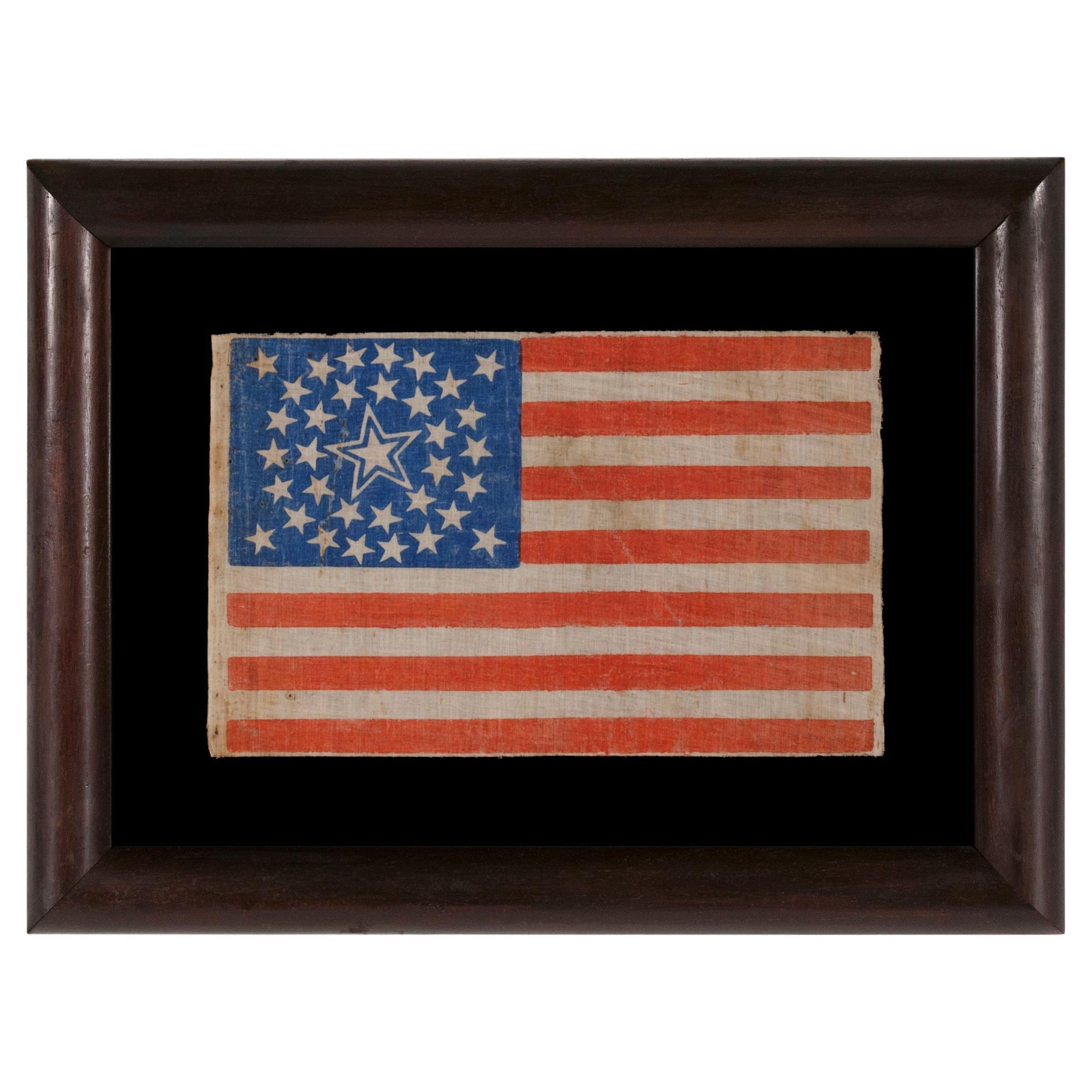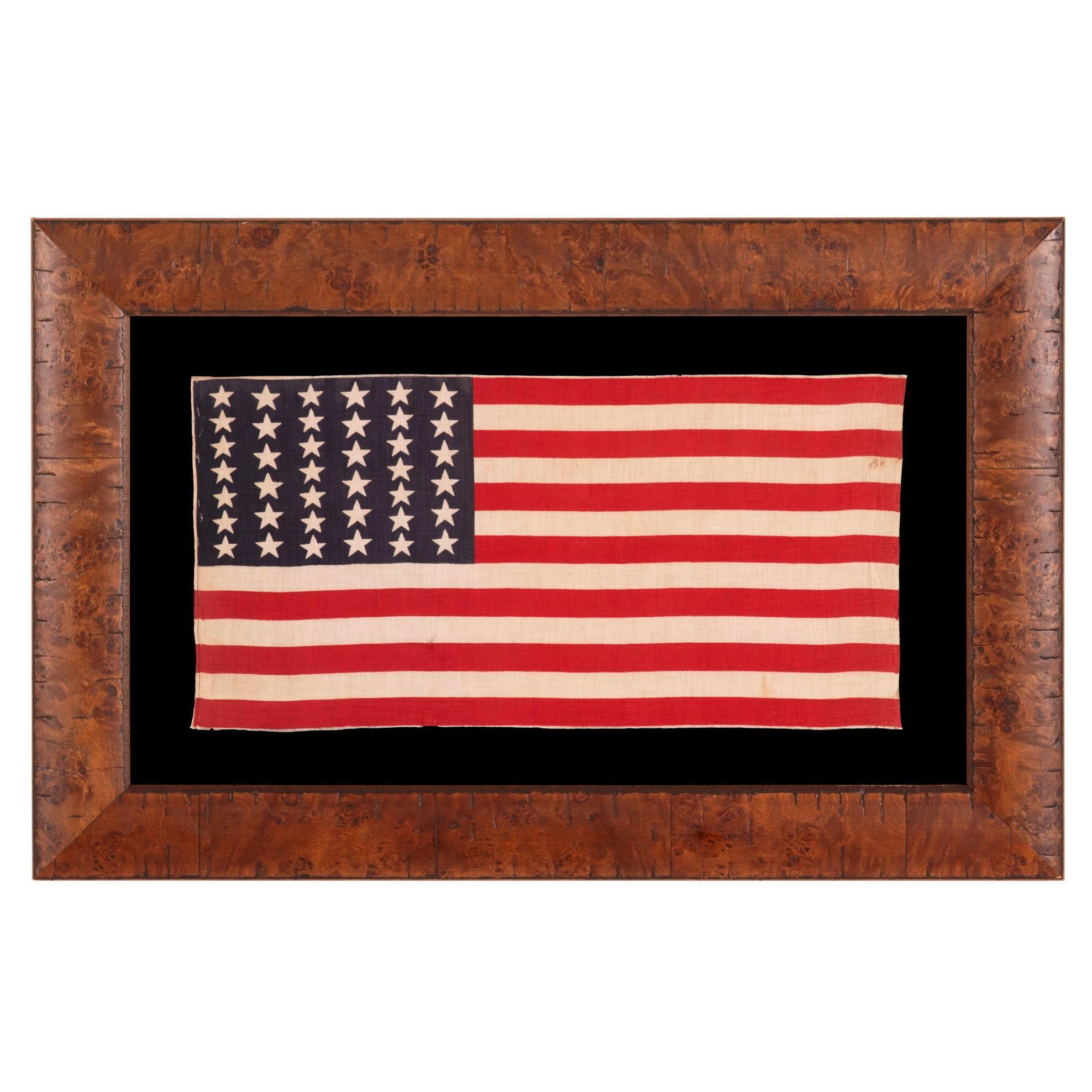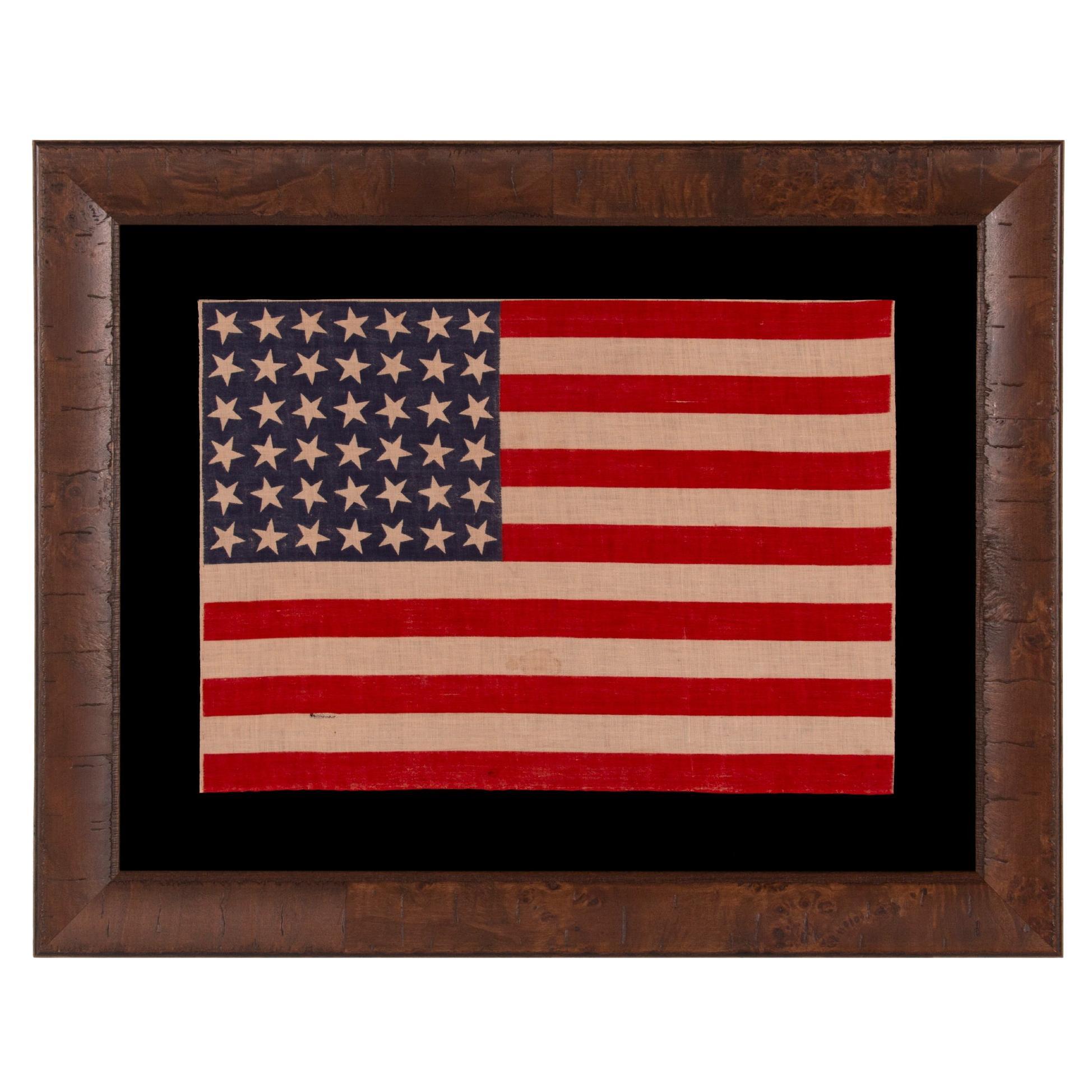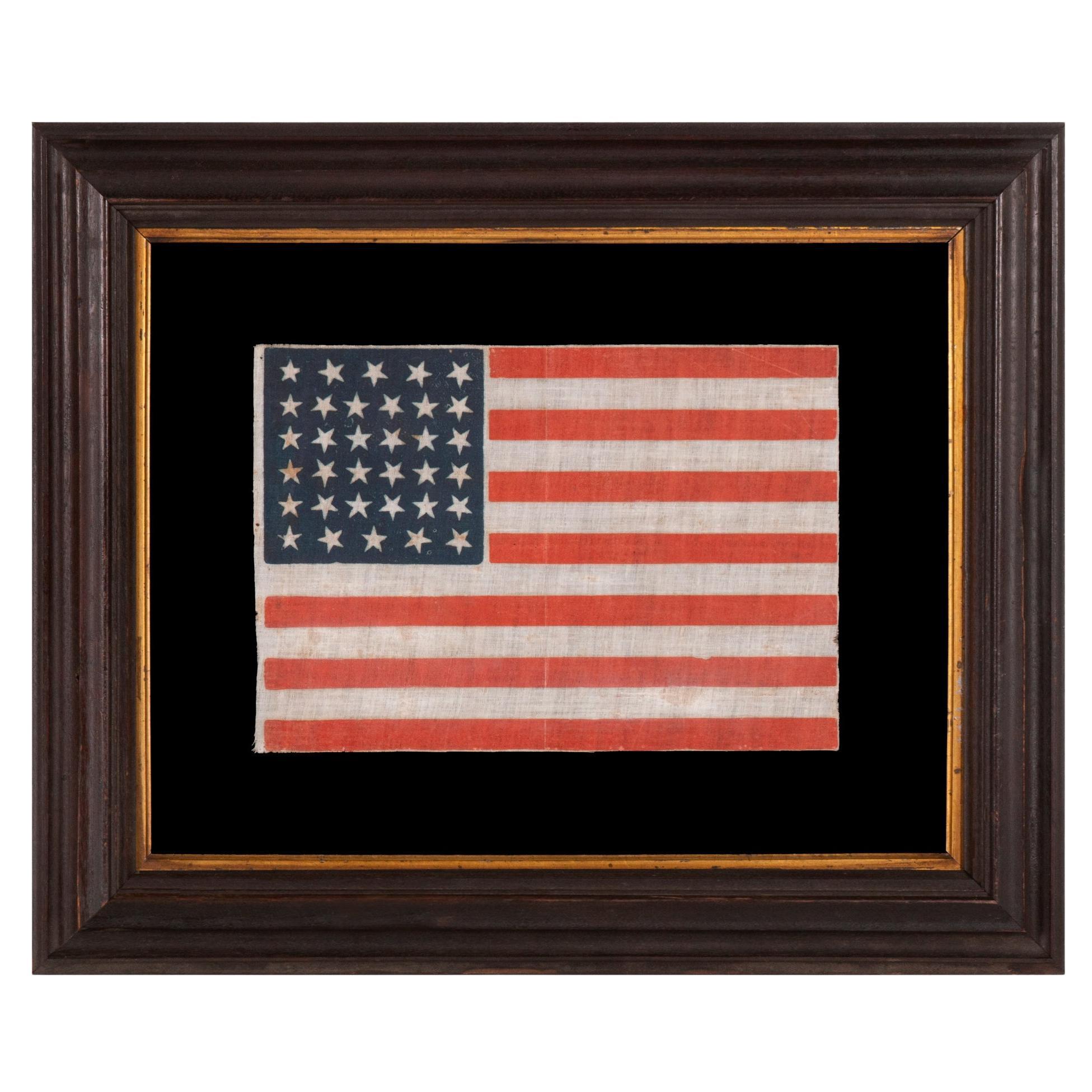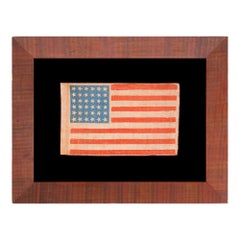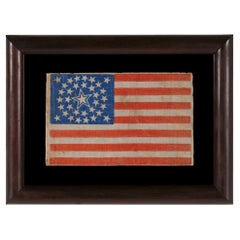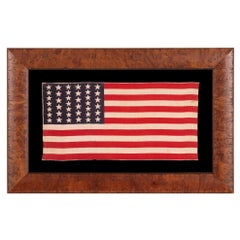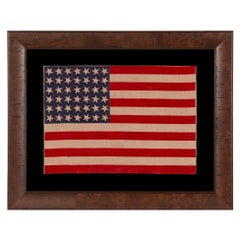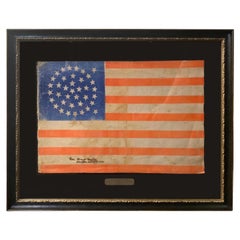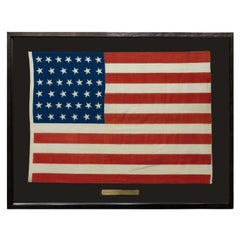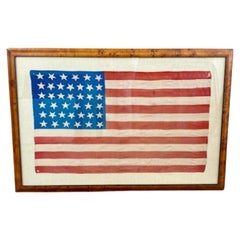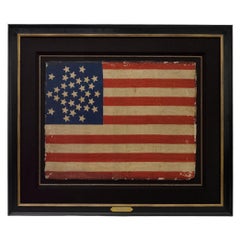Items Similar to 31 Star Parade Flag, Made for the 1860 Campaign of John Bell & Edward Everett
Want more images or videos?
Request additional images or videos from the seller
1 of 6
31 Star Parade Flag, Made for the 1860 Campaign of John Bell & Edward Everett
Price Upon Request
Price Upon Request
Price Upon Request
Price Upon Request
Price Upon Request
Price Upon Request
Price Upon Request
Price Upon Request
Price Upon Request
Price Upon Request
Shipping
Retrieving quote...The 1stDibs Promise:
Authenticity Guarantee,
Money-Back Guarantee,
24-Hour Cancellation
About the Item
31 STAR PARADE FLAG, MADE FOR THE 1860 CAMPAIGN OF JOHN BELL & EDWARD EVERETT, WITH A “UNION AND THE CONSTITUTION” SLOGAN, PROBABLY MADE BY H.C. HOWARD OF PHILADELPHIA
31 star American parade flag, block printed on cotton, made for the 1860 campaign of Constitutional Union Party candidates John Bell & Edward Everett. The stars are arranged in an interesting medallion pattern that, instead of being circular or star shaped, forms a pentagon. A number of variations of the pentagon pattern are known and all are peculiar. In this particular instance, note how the profiles of the stars exhibit the crude, yet whimsical nature of the hand-carved wooden block used to apply pigment to the fabric. Also note that there is a star in each corner of the canton, outside the basic pattern, typical of medallion designs, yet there is also a single star at the very bottom center. A similar star formation, with similarly crude stars, appears on a flag submitted for copyright to the Philadelphia courthouse, by prolific flag-maker H.C. Howard, on July 12, 1860. In his rush to get as many copyrights as possible, he actually combined two designs in one patent, including a written description of a Douglas with 33 stars, across an image of a 31 star flag. Howard copyrighted several flags for all four candidates, in the same month, close on the heels of the national conventions.
The following text is printed in the striped field, in the same blue as the canton: For President, John Bell. For Vice President, Edward Everett. The Union and the Constitution.” Use of punctuation is almost always interesting in overprinted flags, and this is no exception, with commas after the offices, plus large periods after the surnames and slogan.
The 1850-1865 era marked a pivotal time in American party politics. It bore witness to the birth of the Republican Party in 1854, and the end of both the Whigs and the American Party (Know-Nothings), which had basically disappeared by 1860. Lincoln was the Republican candidate, running on the anti-slavery platform. He was hardly the favorite in the beginning of the campaign, winning the party’s nomination from the third ticket.
When the Democrats convened in Charleston in 1860 to nominate a presidential candidate, Douglas succeeded in adding his moderate planks to the party platform. Several Southerners stormed out of the convention, breaking off to form their own party, with John Breckinridge and Joseph Lane as their candidates. Northern Democrats met again in Baltimore a few weeks later and unanimously nominated Douglas for president.
The Democratic Party orchestrated its own demise by splitting into these two factions. John Bell’s Constitutional Union Party, supported by remnants of hardline Whigs, and members of the Know-Nothing Party, split the ballot even further. The fractured field resulted in a win for Lincoln, despite the fact that he didn't even appear on the ballot in several Southern States.
John Bell was born near Nashville, Tennessee in 1797. A 1814 graduate of the University of Tennessee, Bell passed the bar in 1816 and set up a law practice in Franklin. He was elected to the Tennessee State Senate just one year later, in 1817, then declined re-election. He became a U.S. Congressman in 1827, serving 7 terms. During this time he served as Speaker of the House, chairman of the Committee on Indian Affairs, and chairman of the Committee on Judiciary. He served a very brief term as Secretary of War in 1841. In 1847 he was elected to the Tennessee State Congress, and in the same year became a U.S. senator (Whig Party), serving nine years before his run for the presidency.
Bell and his party were the voice of moderation in the rising conflict. They advocated for simply maintaining the Union and enforcing the laws of the Constitution. Bell garnered more than 12.5% of the 1860 vote. This was one of the highest amounts ever received by an independent party candidate; a number only surpassed by Teddy Roosevelt in 1912, on the Bull Moose Party ticket, who received a whopping 27.4%. Bell was the leading Whig in Tennessee. He served fourteen years in the House of Representatives and twelve in the Senate, where he supported the Compromise of 1850, voted against the Kansas-Nebraska Act, and opposed admitting Kansas as a slave state. After his loss, in 1860, Bell went with his state to the Confederacy, but did not play a major role in the CSA government.
Bell’s campaign regalia are of keen interest, because he ran against Lincoln at such a critically studied time in American history. Objects with the “The Union and the Constitution” are even more attractive to collectors, because the words are clear, patriotic, and almost as resonant today as they were 160 years ago. They speak not only to the hopeful avoidance of impending war, but to our nation’s founding principles. Lincoln liked the slogan so much, in fact, that he borrowed it for the 1864 election. Hoping to pick up some of the independent and Southern vote, the Republican Party actually changed its name on the 1864 ticket to the “National Union Party.” [This was for the national ticket. State divisions of the Republican Party, for the most part, did not change their names.]
Bell’s Constitutional Union ticket, in 1860, carried just three states: Tennessee, Kentucky, and Virginia. Bell died at his home in 1869, near Chattanooga, and is buried near Nashville. Born in Boston in 1794, Edward Everett, is a person of significant interest. After studying abroad, in Germany, he returned to the U.S., as the first American to ever receive a Ph.D. He served as Governor of Massachusetts (1836-40), President of Harvard (1846-49), and as Secretary of State (1852-56) under the administration of Millard Fillmore, following the death of his friend, Daniel Webster. Everett was considered the greatest orator of the time, which is why he was selected to give a speech at Gettysburg in 1863, to dedicate the memorial to fallen soldiers. He spoke for two hours, but Americans will forever remember the day, not for Everett, but for Abraham Lincoln, who was asked to follow with a “few appropriate remarks,” now known as the Gettysburg Address. Everett died in Boston in 1865 and was interred in Mount Auburn Cemetery, Cambridge.
Election Results:
Abraham Lincoln, Illinois (R) - 39.8% (PV), 180 (EV)
Stephen Douglas, Illinois (Northern D) - 21.5% (PV), 12 (EV)
John C. Breckinridge, Kentucky (Southern D) - 14.3% (PV), 72 (EV)
John Bell, Tennessee (Constitutional Union) - 12.6% (PV), 39 (EV)
Mounting: Don’t be fooled by the seemingly backwards orientation. In the 19th century, the same flag ethics that exist today did not apply. In fact, display of the American national flag with the canton in the upper left did not enter the American consciousness, as the one correct manner of presentation, until the end of the 19th century, and was not formally dictated as such until the flag code was adopted in 1923. Prior to this time, it was just as common to see the flag displayed with the canton on the right.
The banner was mounted and framed within our own textile conservation department, which is led by expert staff. We take great care in the mounting and presentation of flags and have preserved thousands of examples.
The veneered, mahogany molding, with its ogee profile, dates to the period between 1830 and 1860, has exceptional, early surface, and retains its original, gilded, piecrust liner. The background is 100% hemp fabric or a hem and cotton blend (we use both, interchangeably). Spacers keep the textile away from the glazing, which is U.V. protective glass. Feel free to contact us for more details.
Condition: There is very minor soiling. The last stripe is narrow, either due to an error in layout, or the manner I n which it was trimmed. The overall condition is exceptional.
Frame Size (H x L): 15.75" x 19.75"
Flag Size (H x L): 7.5" x 11.25
- Dimensions:Height: 15.75 in (40.01 cm)Width: 19.75 in (50.17 cm)Depth: 2 in (5.08 cm)
- Materials and Techniques:
- Place of Origin:
- Period:
- Date of Manufacture:1860
- Condition:See Item Descriptio.
- Seller Location:York County, PA
- Reference Number:Seller: 31j-8521stDibs: LU849741275642
About the Seller
5.0
Recognized Seller
These prestigious sellers are industry leaders and represent the highest echelon for item quality and design.
Established in 1991
1stDibs seller since 2008
70 sales on 1stDibs
Typical response time: 1 to 2 days
- ShippingRetrieving quote...Shipping from: York County, PA
- Return Policy
Authenticity Guarantee
In the unlikely event there’s an issue with an item’s authenticity, contact us within 1 year for a full refund. DetailsMoney-Back Guarantee
If your item is not as described, is damaged in transit, or does not arrive, contact us within 7 days for a full refund. Details24-Hour Cancellation
You have a 24-hour grace period in which to reconsider your purchase, with no questions asked.Vetted Professional Sellers
Our world-class sellers must adhere to strict standards for service and quality, maintaining the integrity of our listings.Price-Match Guarantee
If you find that a seller listed the same item for a lower price elsewhere, we’ll match it.Trusted Global Delivery
Our best-in-class carrier network provides specialized shipping options worldwide, including custom delivery.More From This Seller
View All36 Star Antique American Parade Flag, with Canted Stars, ca 1864-1867
Located in York County, PA
36 STAR ANTIQUE AMERICAN PARADE FLAG WITH CANTED STARS IN DANCING ROWS, ON A BEAUTIFUL, CORNFLOWER BLUE CANTON; CIVIL WAR ERA, NEVADA STATEHOOD, 1864-1867
36 star antique American f...
Category
Antique 1860s American Political and Patriotic Memorabilia
Materials
Cotton
Price Upon Request
34 Star Antique American Parade Flag, Kansas Statehood, ca 1861-1863
Located in York County, PA
34 STARS IN A MEDALLION CONFIGURATION ON AN ANTIQUE AMERICAN PARADE FLAG WITH A LARGE, HALOED CENTER STAR; CIVIL WAR PERIOD, KANSAS STATEHOOD, 1861-1863
34 star American national pa...
Category
Antique 1860s American Political and Patriotic Memorabilia
Materials
Cotton
Price Upon Request
39 Star Antique American Parade Flag with Stars in Two Sizes, Ca 1876
Located in York County, PA
39 STARS IN TWO SIZES, ALTERNATING FROM ONE COLUMN TO THE NEXT, ON AN ANTIQUE AMERICAN PARADE FLAG WITH AN UNUSUALLY ELONGATED PROFILE, DATING TO THE 1876 CENTENNIAL, NEVER AN OFFICI...
Category
Antique 1870s American Political and Patriotic Memorabilia
Materials
Cotton
42 Star Parade Flag with Scattered Stars, ca 1889-1890
Located in York County, PA
42 STARS ON AN ANTIQUE AMERICAN FLAG WITH SCATTERED STAR POSITIONING, REFLECTS THE ADDITION OF WASHINGTON STATE, MONTANA, AND THE DAKOTAS, NEVER AN OFFICIAL STAR COUNT, circa 1889-18...
Category
Antique Late 19th Century American Political and Patriotic Memorabilia
Materials
Cotton
34 Star Antique American Parade Flag, Kansas Statehood, ca 1861-1863
Located in York County, PA
34 STARS, WITH SCATTERED POSITIONING, ON AN ANTIQUE AMERICAN PARADE FLAG MADE DURING THE OPENING TWO YEARS OF THE CIVIL WAR, 1861-63, KANSAS STATEHOOD
34 star American national flag...
Category
Antique 1860s American Political and Patriotic Memorabilia
Materials
Cotton
Price Upon Request
30 Star Antique American Parade Flag, Wisconsin Statehood, ca 1848-1850
Located in York County, PA
ANTIQUE AMERICAN PARADE FLAG WITH 30 STARS, THE ONLY KNOWN EXAMPLE IN THIS SIMPLE BUT EXTRAORDINARY STYLE, PRE-CIVIL WAR, OFFICIAL FOR JUST TWO YEARS, REFLECTS THE ADDITION OF WISCON...
Category
Antique Mid-19th Century American Political and Patriotic Memorabilia
Materials
Cotton
Price Upon Request
You May Also Like
38-Star American Parade Flag, Flown at a Reception for President Grant, 1880
Located in Colorado Springs, CO
This is a beautifully colored 38-star American parade flag, flown at a public reception for Ulysses S. Grant in October of 1880. This printed flag features a rare, triple medallion s...
Category
Antique 1880s American Political and Patriotic Memorabilia
Materials
Cotton
39-Star Antique American Flag with 'Whimsical' Star Pattern, 1889
Located in Colorado Springs, CO
This is a 39-star unofficial American flag, handmade and printed on cotton. The flag dates to 1889 and has a unique history, thanks to its rare star-count.
The flag’s canton is prin...
Category
Antique 1880s American Political and Patriotic Memorabilia
Materials
Cotton
19th Century American 39 Star Flag, circa 1889
Located in Nantucket, MA
19th Century American 39 Star Flag, circa 1889, a period printed silk parade flag with a wavy pattern of dancing stars. This was never an official flag of the United States but was m...
Category
Antique 1880s American Federal Political and Patriotic Memorabilia
Materials
Silk
31-Star Printed American Flag, Celebrating California Statehood, Circa 1850
Located in Colorado Springs, CO
This is a rare 31-star medallion printed American flag, celebrating the addition of California to the Union. The flag is printed on silk and has a spectacular “Great Star” canton pat...
Category
Antique 1850s American Political and Patriotic Memorabilia
Materials
Silk
38-Star Antique American Flag with Unique Canton, circa 1876-1890
Located in Colorado Springs, CO
This is a striking 38-star American flag. The flag dates to 1876-1890, when Colorado (represented by the large star in the center of the flag’s canton) joined the Union as the 38th s...
Category
Antique Late 19th Century American Political and Patriotic Memorabilia
Materials
Muslin
39-Star Printed American Flag, Commemorating North Dakota Statehood, 1889-1890
Located in Colorado Springs, CO
This is a 39-star unofficial American flag, celebrating North Dakota statehood. The printed flag dates to 1889 and showcases a “whimsical” star pattern in the canton. The flag's cant...
Category
Antique 1880s American Political and Patriotic Memorabilia
Materials
Fabric
More Ways To Browse
Black Memorabilia
Bell Bottom
Union Flag
Wooden Bell
Antique Wooden Blocks
19th Century American Flag
Black Southern Folk Art
American Flag Cotton
Antique American Flag Framed
Space Memorabilia
Antique End Of Day Glass
Pentagon Design
Star Wars Prints
Staff Wooden Staff
Antique Hemp
Folk Art Soldier
Wooden Soldiers
Boston Furniture Makers
